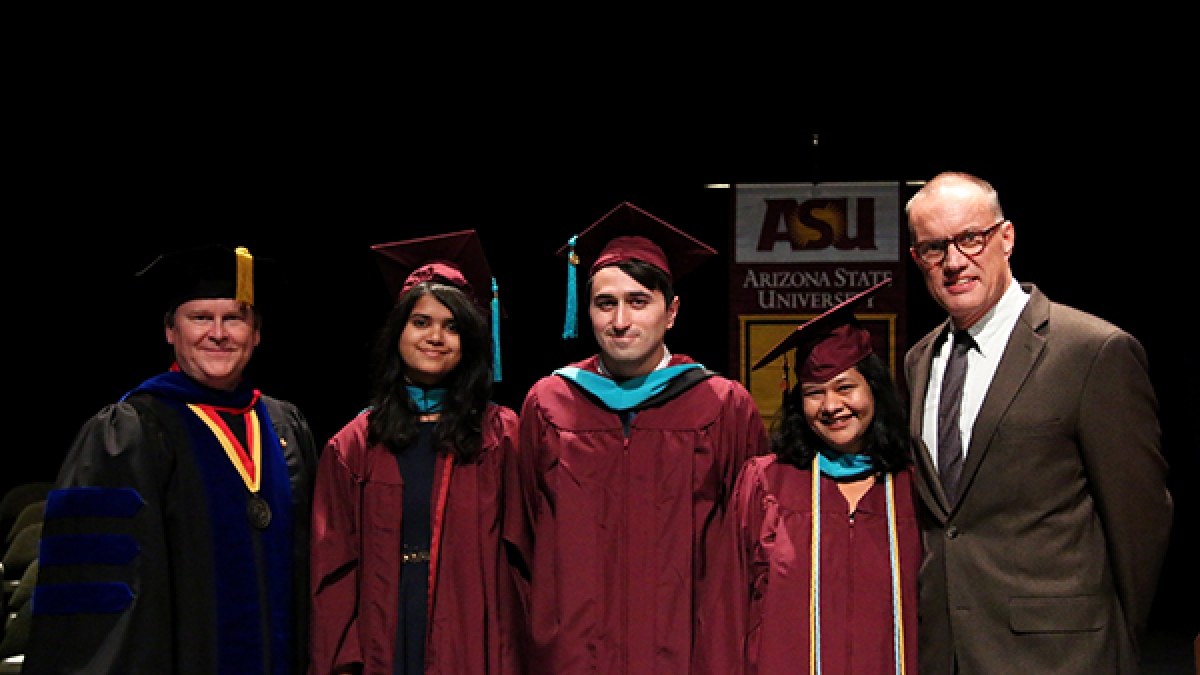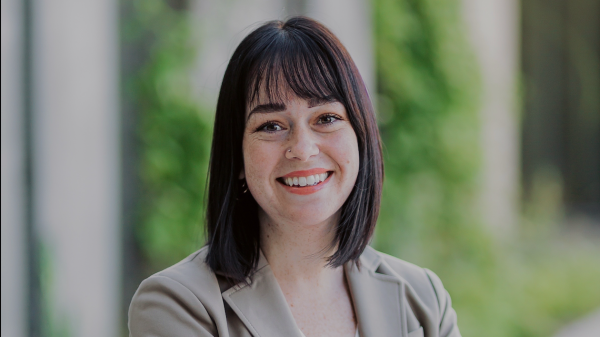Guiding transparency in state budgeting
ASU students help collect data for government finance project

Students who worked on a project collecting state budget data as part of a capstone course celebrate at convocation. Left to right: School of Public Affairs associate professor David Swindell, students Mayuri Roy Choudhury, Robert Celaya and Rekha Athreya, and Morrison Institute's Dan Hunting. Photo by Bryan Mok/ASU
In 2015, the Volcker Alliance conducted an evaluation of three state’s budgeting practices. Now that work is going nationwide and Arizona State University’s Center for Urban Innovation is one of their leading partners. The Volcker Alliance recently announced that it will expand their project into a multiyear study across all 50 states: The Truth and Integrity in Government Finance Project.
“One of the main initiatives of the Volcker Alliance is clean governance,” said David Swindell, director of the Center for Urban Innovation in the School of Public Affairs. “Looking at budget practices, how would someone know what states are doing?”
ASU is one of thirteen academic institutions that will lead data collection. It also serves as project coordinator for the twelve western states.
Students in the Master of Public Administration capstone course began collecting primary data during the summer and fall semesters. Swindell is co-teaching the course with Dan Hunting of ASU’s Morrison Institute for Public Policy (and former fiscal analyst for the Joint Legislative Budget Committee at the state legislature).
The Volcker Alliance has established 29 indicators that serve as the standard measures. Because practices change, teams are looking at the last three fiscal years.
“We went through a series of questions in different buckets: general practices, one-time actions, funding for special items, measures for rainy day funds and disclosure practices,” said ASU Master of Public Administration student Rekha Athreya, who was on a Colorado team. “We looked at websites, bills, reports and spoke with analysts to confirm data or get additional information.”
Two teams were assigned to each state to maintain integrity and reliability in the data collection.
“Basically if one team comes to one conclusion and the other to another, then we have to resolve the differences,” said Swindell. “Another part of the challenge is translating budget jargon.”
He cites local option sales tax as an example. In Arizona, it is called tax at point of transaction. Both are a sales tax. When state law dictates sales tax rates, what qualifies?
Finding the data was another hurdle.
“It was eye-opening that many documents were not in plain view. They weren’t hidden, just not easily available. For me, communication should be dictated by the receiver,” Athreya said.
Robert Celaya, a Master of Public Policy student, worked on the state of Arizona. “Most of the information was on the web and the staff was helpful. But, the website was not that user friendly and data was unorganized. You had to know what you were searching for.”
“Regarding transparency, which is the main goal of the Volcker Alliance, information should be easily available to people. People have to go deep and search,” said Mayuri Roy Choudhury, also a Master of Public Policy student.
Choudhury also noted that it wasn’t just websites.
“We expected the analysts to give us instant answers and that was not the case. Sometimes it took several days and the information didn’t always line up with the questions asked. We spent time to document answers to confirm and avoid any bias,” she said.
“This applied learning gives students a deeper appreciation of the budgeting process, and exposure to different budgeting practices,” Swindell said.
“We learned the gap between research and practice,” Choudhury. There are many things written about budgeting but analysts in practice don’t always know these things.”
“It was interesting to see how Arizona compared. Of the metrics provided, it looked pretty good,” Celaya said.
Data collection is the primary goal for now. Swindell notes that ultimately there will be the opportunity to gain a more contextual view of why practices differ and how variations compare.
“The big payoff is the data,” he said. “No one has looked at the same 29 practices across all states to see how they vary, along with the results of those practices. This study provides an opportunity to identify good practices and show states how they can move in that direction.”
The next round of collection will go through spring, then all of the information will ultimately be put in a standardized platform to guide states’ practices and analyze variation.
“Explaining the variation is what social science does,” Swindell said. “This is an opportunity to introduce innovation to those states who are doing things poorly by empirically demonstrating best practices.”
“Whether or not you agree with the underlying policy, it is important to be transparent in the process,” Celaya said. “This was a great exercise. State budgets affect everyone.”
More University news

Couple with more than 60 years of service to ASU establish student scholarships
Ken Hollin and Michelle Brown-Hollin met, worked together and married each other at Arizona State University. Now, they will both…

First-generation grad earns master's degree in social justice and human rights
Editor’s note: This story is part of a series of profiles of notable spring 2024 graduates. Rockell Schmidt comes across as a…

ASU faculty member elected to American Academy of Arts and Sciences
Arizona State University Professor Robert Boyd is among those newly elected to the American Academy of Arts and Sciences, one of…